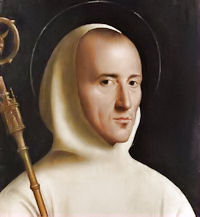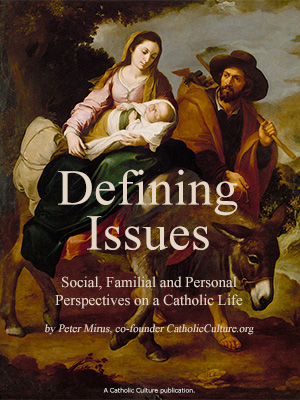Make your gift today!
Help keep Catholics around the world educated and informed.
Already donated? Log in to stop seeing these donation pop-ups.
Lent: April 1st
Friday of the Fourth Week of Lent
Other Commemorations: St. Hugh of Grenoble, Bishop (RM)
» Enjoy our Liturgical Seasons series of e-books!
Communion Antiphon, Eph 1:7:
In Christ, we have redemption by his Blood, and forgiveness of our sins, in accord with the riches of his grace.
The hostility of the enemies of Jesus becomes increasingly clear, and the agitation around His person continues with greater intensity; but He awaits His "hour." Satan and the forces of evil will appear to triumph, but the real victory will come and that is God's. —St. Andrew Missal
St. Hugh of Grenoble is commemorated today in the Roman Martyrology. He was born in 1053 at Chateauneuf, France, and elected Bishop of Grenoble at the age of twenty-eight to purge the diocese of its disorders, and he occupied the see until his death fifty-two years later in 1132.
Meditation
As Jesus neared the end of His public life, the opposition of the Jewish leaders became more violent and their desire to kill Him more determined. Our Lord, however, continued to teach in the temple, where large crowds came to hear Him. The admiration of the people intensified the hatred of the priests, and they planned to ensnare Jesus in His speech that they might have grounds for condemnation. While His enemies plotted His downfall, Our Lord spent the night in prayer on the Mount of Olives.
The contrast between the character of Christ and that of His enemies could not be more pronounced. Yielding to base passion, they were openly seeking the death of the Messiah. Jesus, on the contrary, in the spirit of generous charity, was spending His days in teaching and His nights in prayer. Does our conduct in difficult circumstances resemble that of Christ? When we are unjustly accused, criticized, or condemned, do we calmly continue our work and have recourse to God in prayer? Perhaps we seek vengeance upon those who oppose us by wishing them evil or persuading others to despise and condemn them. Let us leave our reputation in the hands of God and imitate Christ's efforts to benefit those who hated and condemned Him.
"The Lord is the protector of my life: of whom shall I be afraid?"
—Excerpted from Liturgical Reflections, Sisters of St. Dominic
Things to Do:
- If you wish to gain the courage to embrace the small crosses in your life with joy, pray the Stations of the Cross. This is an excellent practice that should not only be confined to Lent but ought to be prayed on Fridays throughout the year. An excellent version with beautiful meditations composed by Pope John Paul II is his Stations of the Cross at the Colosseum. Some recommended versions are: Eucharistic Stations of the Cross, and the more traditional Stations of the Cross written by Saint Alphonsus Liguori can be found in most Catholic bookstores. Here are some guidelines for praying the Stations of the Cross in your home.
St. Hugh of Grenoble (or Châteauneuf)
In the eleventh century the diocese of Grenoble in southeastern France was notorious for corruption. Simony (the buying and selling of spiritual goods), usury, immorality, and ignorance were rampant in that area. During a Church synod at Avignon in 1080, it was decided that a strict bishop should be appointed to correct these abuses; one who could lead both clergy and laity to conform to the laws of the Church. Saint Hugh was unanimously elected to the office.
Hugh was born near Valence in southern France in 1053. After completing his formal education, he accepted a canonry (an official membership in the bishop's council) in the cathedral of that city. In his early twenties, he met the bishop of Die, who was impressed by Hugh's virtue and administrative talents and offered him a position in his own diocese. Hugh accepted the offer and later went with the bishop to the synod at Avignon, where he was unexpectedly elected to the see of Grenoble. After being ordained at the age of twenty-seven, he was consecrated bishop by the pope.
For two years, Hugh preached, fasted, and prayed in an effort to correct the many abuses in his diocese. Then, feeling that a new bishop might be more successful, he resigned and entered the novitiate at the Benedictine abbey of Chaise-Dieu. He was there only a short time when Pope Gregory VII commanded him to return to his see. Once again in Grenoble, Hugh more effectively fought the evils in his diocese. The poor were his greatest concern; once, during a time of famine, he sold his ornate gold chalice to buy them food. In 1084, when Saint Bruno, founder of the Carthusian Order, was looking for a site for a new monastery, Hugh, guided by a dream, granted him the territory known as "the Chartreuse" which gave the order its name. Hugh is often portrayed in art in connection with the Carthusians; he admired the monks and frequently visited them, happily joining in their exercises and performing the most menial tasks.
Throughout his fifty-two years as bishop of Grenoble, Hugh harbored a desire for contemplative life, but because of the tremendous influence of his holiness, pope after pope refused to release him from office. He died after a long illness and was canonized two years later by Pope Innocent II.
—The Lives of the Saints for every day of the year, Vol. 1: January-April
Patronage: against headaches; Grenoble, France
Symbols and Representation: carrying a lantern; one of a group of seven stars, representing the founders of the Carthusians; with Saint Bruno; with three flowers in his hand
Highlights and Things to Do:
- Read more about St. Hugh:
- In 1084 St. Hugh gave to St. Bruno and his six companions the land of La Grande, a desert in his diocese, called the Chartreuse, where they could live in solitude. It was here that St. Bruno founded the Carthusians. The entire name of the Carthusians is "Order of the Chartreuse." The liqueur Chartreuse originates from the Carthusians. Find out the history.
- Find out more about Carthusian monks and see the list of monasteries in the world.






